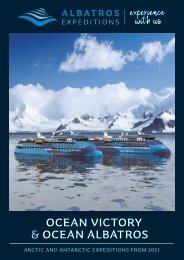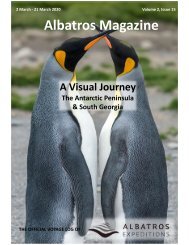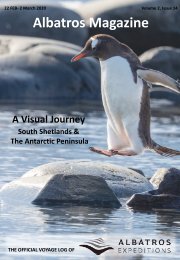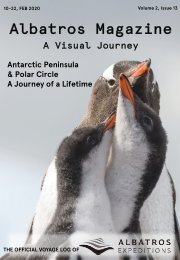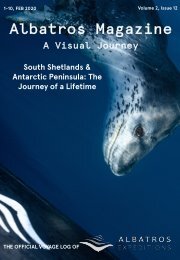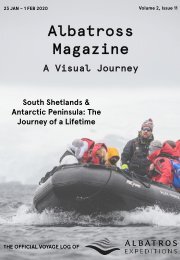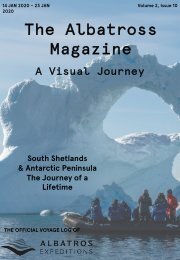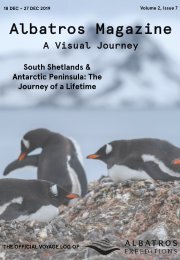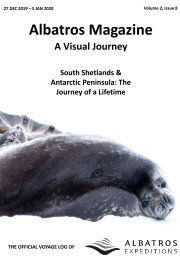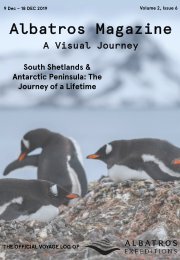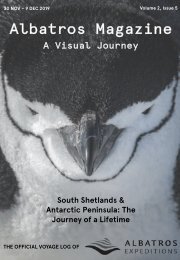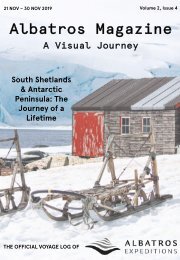V9 Antarctic Peninsula_Voyage_Log
Create successful ePaper yourself
Turn your PDF publications into a flip-book with our unique Google optimized e-Paper software.
<strong>Antarctic</strong>a: A Continent for Science<br />
David Macdonald, Lecturer (Geology) & Expedition Guide<br />
Until the advent of mass tourism, <strong>Antarctic</strong>a’s tagline was: “A continent for science”.<br />
23<br />
<strong>Antarctic</strong>a affects the rest of the world in a variety of<br />
ways, so “<strong>Antarctic</strong> Science” should really be “Global<br />
science that happens in <strong>Antarctic</strong>a”. Although many<br />
early expeditions were purely geographical in scope,<br />
there were some important scientific expeditions in the<br />
late 19 th to early 20 th centuries. In this “Golden Age” of<br />
exploration, there were many scientific contributions<br />
from <strong>Antarctic</strong>a which changed our view of the earth’s<br />
evolution and environment.<br />
Indeed, three expeditions brought back proof that<br />
<strong>Antarctic</strong>a once had a warm climate. Scott’s first<br />
expedition (1901-1904) found coal from 250 million<br />
years ago in the Transantarctic Mountains;<br />
Nordenskjӧld’s Swedish <strong>Antarctic</strong> Expedition found<br />
warm-water fossils on James Ross Island; and the Scotia<br />
Expedition under Bruce (1902-1904) dredged<br />
fossiliferous 500 million-year-old limestone from the<br />
Weddell Sea. Scott’s second expedition (1910-1913)<br />
found fossil leaves(Glossopteris) in the Transantarctic<br />
Mountains. These fossils belong to an extinct order of<br />
seed ferns from 299-252 million years ago, only found<br />
in the southern hemisphere continents and India. They<br />
were used by Wegener in 1924 in his work on<br />
continental drift to reconstruct the former<br />
supercontinent of Gondwana.<br />
In the years after the First World War, the focus<br />
changed from individual expeditions to national<br />
pursuits, such as the British Discovery Investigations –<br />
the first permanent oceanographic body in the world.<br />
During 33 years (1918–51) of pioneering work, the<br />
research ships collected an enormous amount of<br />
oceanographic, biological, and geographical data.<br />
Among the results of the investigations was the<br />
discovery of both the Mid-Atlantic Ridge and the<br />
<strong>Antarctic</strong> Convergence - the natural boundary of<br />
<strong>Antarctic</strong>a.<br />
By the end of the Second World War, the move to<br />
create national organisations was complete, with the<br />
formation of the Falkland Islands Dependencies Survey<br />
(now British <strong>Antarctic</strong> Survey), the Australian National<br />
Research Expeditions) and other civilian operations<br />
(France, New Zealand, South Africa, etc).<br />
As a result of these organisations and better logistics,<br />
the rate of scientific discovery soared, and new polarspecific<br />
studies proliferated. Some highlights include:<br />
• 1957-58: The International Geophysical Year (IGY)<br />
was an 18-month collaboration between 67<br />
countries. <strong>Antarctic</strong>a was the focus, with 12 nations<br />
participating. Many new scientific stations were<br />
created and the IGY was a resounding success as it<br />
led directly to the <strong>Antarctic</strong> Treaty<br />
• 1959-1996: The discovery and delineation of<br />
subglacial Lake Vostok is a great example of scientific<br />
cooperation. Lab studies showed that ice under very<br />
high pressure reverts to water and in 1964, seismic<br />
soundings from Vostok Station were used to<br />
measure the thickness of the ice sheet. This<br />
suggested the existence of a subglacial lake. British<br />
airborne ice-penetrating radar in the 1970s detected<br />
unusual radar readings, suggesting a freshwater lake<br />
below the ice. In 1991, a radar satellite revealed<br />
that this subglacial water body is one of the world’s<br />
largest lakes. We now know that there are at least<br />
140 subglacial lakes in <strong>Antarctic</strong>a.<br />
• 1980-present: The US-funded collection and curation<br />
of <strong>Antarctic</strong> meteorites has recovered about 22,000<br />
meteorites from <strong>Antarctic</strong>a (about 75% of all known<br />
meteorites worldwide). There are samples from the<br />
Moon, Mars, and asteroids.<br />
• 1985: In hole in the ozone layer over <strong>Antarctic</strong>a was<br />
discovered from ground-based instruments at Halley<br />
Bay and Faraday (British <strong>Antarctic</strong> Survey).<br />
• 1986: Research at McMurdo Station, the main U.S.<br />
scientific station in <strong>Antarctic</strong>a, established that<br />
chlorofluorocarbons (CFCs) as the probable cause of<br />
the <strong>Antarctic</strong> ozone hole (US NSF). These two bits of<br />
work lead to signing of the Madrid Protocol on 1987,<br />
banning CFCs.<br />
5 JAN 2020 – 14 JAN 2020<br />
Volume 2, Issue 9




